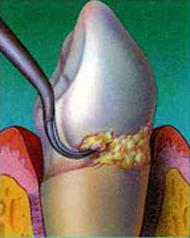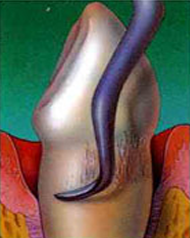Gum (Periodontal) Diseases
A gum problem or disease is one aspect of oral health which has been dealt with rather casually.
-
- Gum problems need more attention because these gum infections are chronic and painless
- Very often when the patient comes in for dental help the condition is in an advanced and irreversible stage leading to tooth loss
So take a quick look and evaluate your gum condition, to see if they are healthy enough.

This table summarizes the stages of gum (periodontal )disease progression and their associated signs and symptoms
- HEALTHY
- Coral pink color
- Gums hug teeth tightly
- No bleeding
- GINGIVITIS
- Bleeding while brushing or during probing
- Inflamed, sensitive gums
- Possible bad breath/taste
- MILD PERIODONTITIS
- More pronounced gingival bleeding, swelling
- Gums may begin to pull away from teeth
- Bad breath/taste
- Pockets 3-4 mm deep
- MODERATE PERIODONTITIS
- Gum recession
- Gum boils or abscesses may develop
- Bad breath/taste
- Teeth may begin to drift and show spaces
- Pockets 4-6 mm deep
- ADVANCED PERIODONTITIS
- Teeth may become mobile or loose
- Constant bad breath and bad taste
- Teeth sensitive due to exposed roots
- Pockets > 6mm deep
Depending on how advanced your particular case is, treatment may involve any of the following:
Periodontal disease may be need Surgery .

Plaque and tartar (yellow or brown Hardened plaque) are scraped off the tooth's crown and roots.

After Scaling, the rough surfaces of the root are smoothed, providing a healthy surface for healing.
Flap / Osseous Therapy allows the periodontist to gain access to the root of the tooth for removal of plaque, calculus, and diseased tissue. The gum is then carefully sutured back into place. Flap therapy may sometimes be accompanied by minor osseous (bone) shaping or removal in order to ease tissue positioning, facilitate home care, and simplify your maintenance appointments.

The gum is lifted from the tooth and bone, and diseased tissue is removed. The uneven bone may also may be reshaped.

After surgery, the gum is repositioned and sutured in place.
What You Can Do...
Periodontal health begins at home. Together with the state-of-the-art treatment methods
available today, you can be confident your teeth can be saved.
Your dentist is the first line of defense and in the best position to detect the
early signs of periodontal disease.
The objective of periodontal therapy is to prevent tooth loss.

